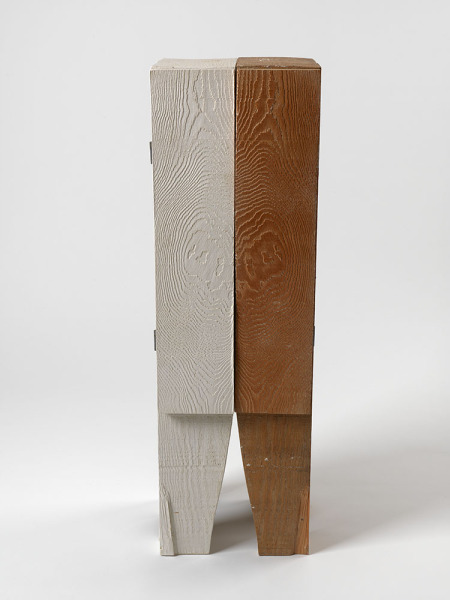Malayalam (from the 'Palindrome' series) (W164)
Catalogue Record
Collection
Maker
Peter Marigold
Title
Malayalam (from the 'Palindrome' series)
Made in
London
Date
2010
Materials and techniques
The piece combines carpentry and casting techniques:
1. A box mould is constructed from timber.
2. The interior of the mould is cast into.
3. The mould is opened up.
4. The cast has the texture of the wood.
5. The wood pieces are flipped inside out.
6. A reversed impression of the wooden side now exists.
7. The two sides are joined together.
The wood used is European Douglas fir. The casting material is jesmonite, a non-toxic water based alternative casting/ laminating material.
The wood was prepared with a Festool Rustofix machine.
1. A box mould is constructed from timber.
2. The interior of the mould is cast into.
3. The mould is opened up.
4. The cast has the texture of the wood.
5. The wood pieces are flipped inside out.
6. A reversed impression of the wooden side now exists.
7. The two sides are joined together.
The wood used is European Douglas fir. The casting material is jesmonite, a non-toxic water based alternative casting/ laminating material.
The wood was prepared with a Festool Rustofix machine.
Dimensions
height: 110cm
width: 30cm
depth: 20cm
Object number
W164
Category
Maker's statement
The first 'Palindrome' series was created for Design Miami/ Art Basel 2009. It was a response to the brief set for the award Designers of the Future Award which specified the use of plaster and mirror as the primary materials with which to build an installation.
This piece was created as a second wave of objects in the ongoing series. I began to play around with creating individual pieces that were determined only by the size of the timber I received - using each plank as a 'unit' - so that the pieces' 'design' is reduced to my stock, rather than trying to find stock that would fit a particular form.
What are your sources of inspiration/reference for this piece?
My experience of symmetry and wondering 'why do we make symmetrical furniture?'
I was also thinking about very basic casting techniques - such as concrete 'fair facing' (as can be seen on the South Bank Centre). By using a basic mould the 'design' aspect can be reduced to a simplified form - the furniture becomes a symbol as much as a functional object. By reducing them in this way, the highly decorative surfaces are given attention.
This piece was created as a second wave of objects in the ongoing series. I began to play around with creating individual pieces that were determined only by the size of the timber I received - using each plank as a 'unit' - so that the pieces' 'design' is reduced to my stock, rather than trying to find stock that would fit a particular form.
What are your sources of inspiration/reference for this piece?
My experience of symmetry and wondering 'why do we make symmetrical furniture?'
I was also thinking about very basic casting techniques - such as concrete 'fair facing' (as can be seen on the South Bank Centre). By using a basic mould the 'design' aspect can be reduced to a simplified form - the furniture becomes a symbol as much as a functional object. By reducing them in this way, the highly decorative surfaces are given attention.

